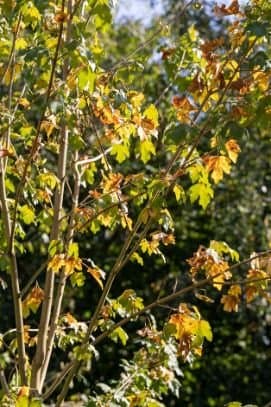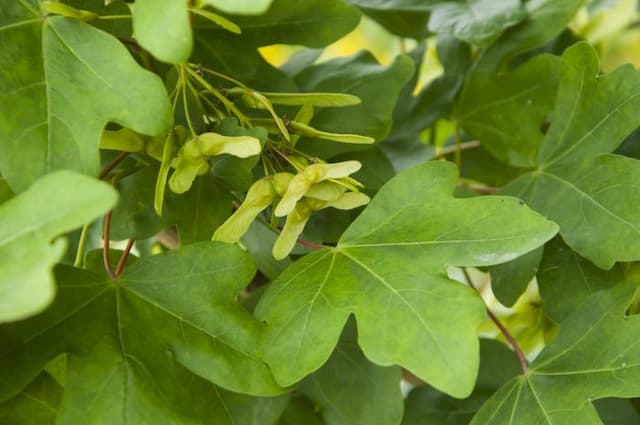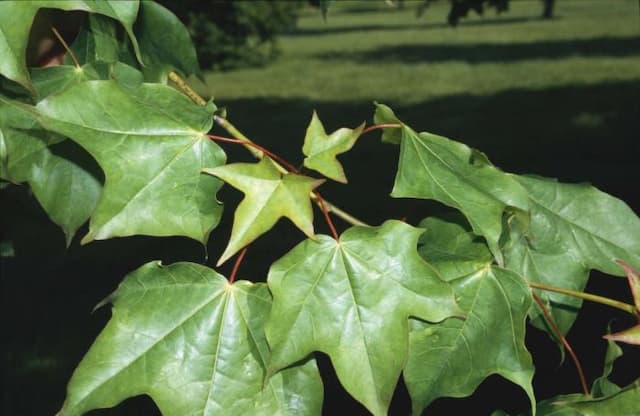Japanese Maple Acer palmatum 'Winter Flame' (P)

ABOUT
The Japanese maple 'Winter Flame' presents a striking display of colors through the seasons. It has a finely-textured foliage that changes hues as the months progress, beginning with a bright coral-pink in spring. As the leaves emerge, their unique palmate shape, which resembles an open hand with outstretched fingers, is highlighted with shades of orange and yellow edges. The leaves have multiple lobes, contributing to the plant's delicate and intricate appearance. As summer approaches, the leaves transform into a lush green, providing a cool, serene canopy. In autumn, the plant really lives up to its name 'Winter Flame', as the foliage ignites into a fiery display of bright reds, oranges, and yellows, resembling flames licking the air. This colorful cascade stands in stark contrast to the more subdued natural autumnal landscape, making it a focal point in any garden space. The bark on 'Winter Flame' is also of interest, as in the winter, after the leaves have fallen, the bark on the twigs and younger branches exhibit bright red tones, which can be quite vibrant and provide winter interest in the landscape. The overall visual effect of the Japanese maple 'Winter Flame' is that of a plant which boasts a year-round aesthetic appeal, from the soft pastels of spring, deep greens of summer, vivid autumnal colors, to the intense warm bark of winter. Its graceful and arching branch structure further adds to its ornamental value, offering a sense of elegance and tranquility.
About this plant
 Names
NamesFamily
Sapindaceae
Synonyms
Winter Flame Japanese Maple, Winter Flame Maple
Common names
Acer palmatum 'Winter Flame'.
 Toxicity
ToxicityTo humans
The Japanese Maple 'Winter Flame' is generally not considered to be toxic to humans. There are no significant symptoms of poisoning associated with this plant, as it is not known to contain any harmful substances that would cause adverse effects if any parts of it were ingested in small quantities. However, as with any plant, individual allergies or sensitivities may exist.
To pets
The Japanese Maple 'Winter Flame' is not typically known to be toxic to pets either. It does not contain substances that are commonly regarded as poisonous to dogs, cats, or other household pets. There should not be any significant symptoms of poisoning as a result of ingesting this plant. Nonetheless, it is always prudent to prevent pets from consuming plants, as individual reactions can vary, and overconsumption of non-food items can cause gastrointestinal distress.
 Characteristics
CharacteristicsLife cycle
Perennials
Foliage type
Deciduous
Color of leaves
Mixed
Height
6-8 feet (1.8-2.4 meters)
Spread
6-8 feet (1.8-2.4 meters)
Plant type
Tree
Hardiness zones
5-8
Native area
Japan
Benefits
 General Benefits
General Benefits- Visual Interest: Acer palmatum 'Winter Flame', commonly known as Japanese Maple, offers a striking display of colors throughout the seasons, with fiery red stems that stand out during winter months.
- Year-Round Appeal: The plant boasts changing foliage that ranges from bright green in spring, to golden-yellow or red in autumn, providing visual appeal in every season.
- Compact Size: Japanese Maples are well-suited for small gardens or spaces, as they typically grow to a modest size and can be easily pruned to maintain shape and scale.
- Shade Tolerance: These maples can thrive in a variety of lighting conditions, including partial shade, making them versatile in different garden settings.
- Low Maintenance: Once established, Japanese Maples generally require minimal care, demanding less time and effort for upkeep compared to many other garden plants.
- Attracts Wildlife: The tree can attract birds and other wildlife to the garden, adding life and interest to the environment.
- Drought Tolerance: With proper care and once mature, Japanese Maples can show resistance to drought, making them suitable for drier climates.
- Moderate Growth Rate: The moderate growth rate of these trees allows gardeners to enjoy their beauty without aggressive expansion that requires frequent pruning or re-planting.
 Medical Properties
Medical PropertiesThis plant is not used for medical purposes.
 Air-purifying Qualities
Air-purifying QualitiesThis plant is not specifically known for air purifying qualities.
 Other Uses
Other Uses- The bark of Japanese Maple can be used for creating natural dyes, giving fabric and yarn a unique hue that reflects the tree's color palette.
- Wood from Japanese Maple is sometimes incorporated into fine woodworking and artisan crafts due to its interesting grain and coloration.
- Dried branches can be used in floral arrangements or as standalone decorative elements in interior design.
- Japanese Maple leaves can be pressed and preserved in artwork, providing a distinct seasonal aspect to the composition.
- The leaves can also be used as a natural mulch, which will break down and enrich the soil with nutrients.
- Crafted into a bonsai, a Japanese Maple becomes a living art piece, requiring meticulous care and shaping.
- When pruned, the smaller branches can be repurposed into walking sticks or even fashioned into rustic handrails or supports for climbing plants.
- In photography, Japanese Maple serves as a stunning subject throughout different seasons due to its varying foliage colors.
- The tree can be used as a privacy screen or garden backdrop, especially in the winter when the red stems stand out against the snow.
- Leaves of the Japanese Maple might be incorporated into handmade paper, providing a textured, organic feel to the finished product.
Interesting Facts
 Feng Shui
Feng ShuiThe Japanese Maple is not used in Feng Shui practice.
 Zodiac Sign Compitability
Zodiac Sign CompitabilityThe Japanese Maple is not used in astrology practice.
 Plant Symbolism
Plant Symbolism- Transformation: The Acer palmatum, commonly known as Japanese Maple, often symbolizes change or transformation due to its leaves that change color throughout the seasons, specifically the 'Winter Flame' variety which transforms from green to bright red or orange.
- Peace: In Japanese culture, the maple tree is a symbol of peace and serenity, which reflects the calming aesthetic of Japanese gardens where these trees are commonly found.
- Balance: The delicate yet robust nature of the Japanese Maple represents balance, with its finely cut leaves balanced by strong growth and adaptability.
- Beauty: With its striking colors, especially the fiery winter hues of the 'Winter Flame' cultivar, the Japanese Maple is often associated with beauty and the appreciation of aesthetic values.
- Longevity: Being a tree that can live for many decades, the Japanese Maple also represents longevity and endurance.
 Water
WaterJapanese Maple 'Winter Flame' prefers consistently moist soil, but it's important not to overwater. Water the plant when the top 2-3 inches of soil feel dry to the touch. A good method is to water deeply and slowly, to ensure that the water reaches the roots rather than just wetting the surface. During the growing season, this might amount to watering once or twice a week, depending on weather conditions. Generally, applying 1-2 gallons of water each time should be sufficient, but always check the soil moisture level before watering to avoid waterlogging.
 Light
LightJapanese Maple 'Winter Flame' thrives in a spot with partial shade to full sun exposure. However, it benefits from some protection from the hot afternoon sun to prevent leaf scorch, especially in warmer climates. A location that provides morning sunlight and afternoon shade would be ideal for promoting vibrant foliage colors without the risk of damage from intense heat.
 Temperature
TemperatureJapanese Maple 'Winter Flame' can tolerate a range of temperatures, but it grows best in conditions between 60°F to 80°F. It is hardy and can survive in temperatures as low as -20°F but should be protected from harsh winter winds. During the summer, providing shade during the hottest part of the day can help maintain an optimal temperature and prevent stress.
 Pruning
PruningPrune Japanese Maple 'Winter Flame' to remove dead or damaged branches, promote good structure, and enhance its natural shape. The best time to prune is late fall to mid-winter when the tree is dormant, as pruning during the growing season can lead to sap loss and stress. Pruning every 2-3 years is generally sufficient, but light annual maintenance may be needed to remove any problematic growth.
 Cleaning
CleaningAs needed
 Soil
SoilJapanese Maple 'Winter Flame' thrives in well-draining soil with a pH of 5.5 to 6.5. A mix of loam, peat, and sharp sand is ideal to facilitate drainage while retaining adequate moisture.
 Repotting
RepottingJapanese Maple 'Winter Flame' should be repotted every two to three years to refresh the soil and accommodate root growth.
 Humidity & Misting
Humidity & MistingJapanese Maple 'Winter Flame' prefers moderate humidity levels but is adaptable to the normal outdoor humidity range in its growing zones.
 Suitable locations
Suitable locationsIndoor
Place Japanese Maple 'Winter Flame' in bright, indirect light indoors.
Outdoor
'Winter Flame' does well in dappled sunlight and protected from strong winds.
Hardiness zone
5-8 USDA
 Life cycle
Life cycleAcer palmatum 'Winter Flame', commonly known as Japanese Maple 'Winter Flame', begins its life cycle as a seed, which after stratification, germinates in the spring. The seedling then develops into a young sapling, where it establishes a root system and begins to grow its distinctive palmate leaves. As the sapling matures into an adult tree, it undergoes seasonal changes, with leaves turning from green to bright orange-red and gold in the autumn before they are shed. Throughout its maturity, the Japanese Maple 'Winter Flame' experiences annual growth in both height and canopy spread, and it will also begin to produce seeds once it reaches sexual maturity. This tree can live for several decades, and throughout its life, it requires well-drained soil, partial shade, and protection from harsh conditions to thrive. After its long life, the tree will eventually senesce and die, completing its life cycle.
 Propogation
PropogationPropogation time
Early Spring
The Japanese Maple 'Winter Flame' is often propagated by softwood cuttings taken during the early summer. To successfully propagate, cut a piece of stem about 4 to 6 inches long, remove the lower leaves, and dip the cut end in a rooting hormone before planting it in a mixture of peat and perlite. The cutting should be protected from intense sunlight and kept consistently moist, but not waterlogged. A plastic cover can help maintain humidity levels conducive to rooting. Roots typically develop within a few weeks, after which the new sapling can be gradually acclimatized to less humid conditions before eventual transplanting.







![Freeman maple [Autumn Blaze]](/_next/image?url=https%3A%2F%2Fplants-admin.emdemapps.com%2Fimages%2Fplants%2F%2Fimages%2F604b575b84d87.png&w=640&q=75)

